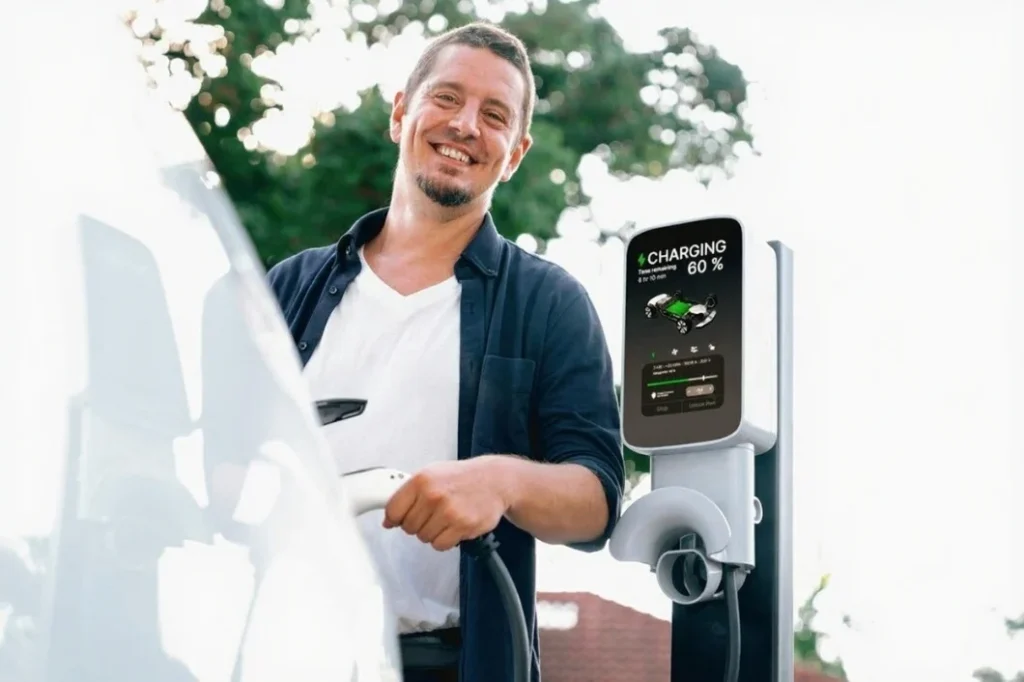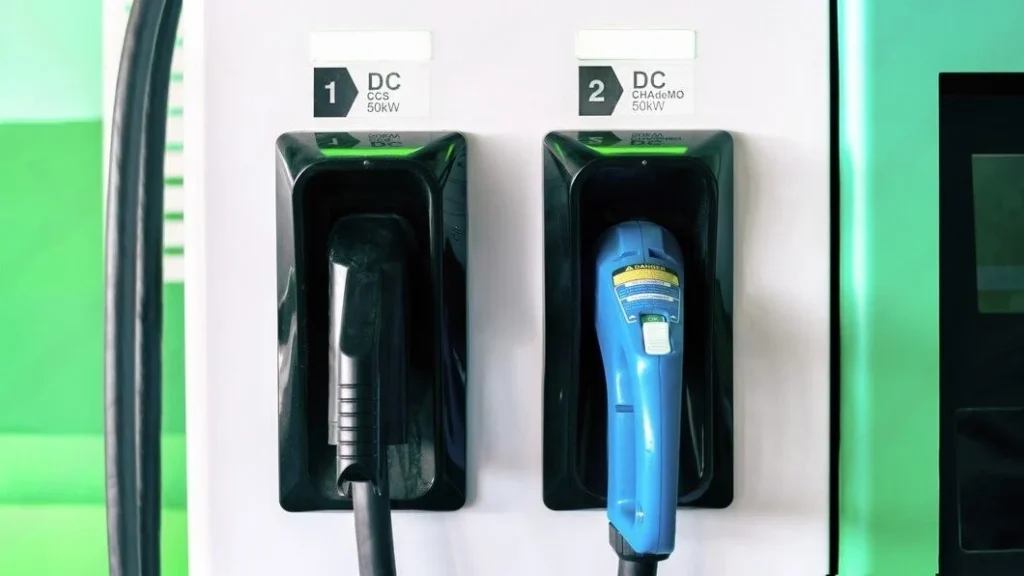As EVs continue to gain popularity, an increasing number of homeowners are opting for Level 2 chargers that offer faster and more efficient charging. But what is this Level 2 EV charging station, and what Level 2 charger requirements must one follow while doing a home installation?
In this complete guide, we will walk through everything there is about Level 2 charger specs, electrical requirements, installation requirements, and much more, so your EV charging setup moves forward without surprises.
What is a Level 2 EV Charging Station?
A Level 2 EV charging station is a charging unit for the home or public charging that works on 240 volts, as compared to 120 volts for a Level 1 charger, the latter simply being the usage of a standard wall outlet. Significantly cutting down on charging times, this charging option is best suited for those who extensively use their EVs every day or have rather long commutes.
Charging Speed: Typically, a Level 2 charger will deliver anywhere from 10-60 miles of range per hour, depending upon the specific vehicle and charger specs. This is quite an upgrade from Level 1 chargers, which give only 3 to 5 miles of range an hour.

Installation: A Level 2 charger installation involves an outlet with 240 volts, and it would be best to hire a licensed electrician for safe and efficient installation. Though some DIY lovers might want to try their hand at the installation of such a charger, we strongly recommend against it due to the inherent danger that comes with high-voltage electrical systems.
While Level 1 charging would be enough for light charging, Level 2 charging is the method preferred by daily EV drivers who desire a faster, more reliable way of keeping their cars fully charged.
Level 2 EV Charger Electrical Requirements
Certain electrical requirements need to be in place for a Level 2 EV charger to work properly and safely. The particularities of such requirements include:
240 Volt Circuit: This is a big one. Without a 240-volt circuit, you are unable to get a Level 2 installation done. It supplies more power than a typical 120-volt outlet and thus becomes essential for charging an EV at a higher rate.
Dedicated Circuit: For a Level 2 charger installation, a dedicated 240-volt circuit is necessary. This means that it should not share a circuit with any other home appliance. This prevents overloading and adequately supplies power to the charger to help it charge the vehicle efficiently.
Circuit Breaker: It should be a double-pole circuit breaker to withstand the higher voltage. The amperage rating of the breaker ranges anywhere between 20 and 60 amps, depending on the charger in question and the watts it gives. A bigger amperage rating means faster charging but requires more electrical capacity.
Wiring: The wiring should be capable of handling the huge current drawn by the Level 2 charger. Usually, 8–10-gauge wire is utilized in most installations; however, this depends upon the amperage of the charger and the distance from the electric panel.
Amperage: The number of amps the charger has will determine how quickly it charges your EV. Level 2 chargers generally are designed with popular setups like 30-amp, 40-amp, and 50-amp models. Among these, the 32 Amp and 40 Amp EV Charger options are the most common for home users, offering a balance between safe electrical load and practical charging speed depending on the EV’s battery size and daily driving needs. A 30-amp charger is ideal for daily drivers who prefer consistent overnight charging while keeping their home’s electrical system balanced and stress-free.
For those who want the fastest home charging possible, 50 Amp EV Chargers steps in as a high-capacity option built to deliver greater power without compromising efficiency. When comparing 40 Amp vs 50 Amp EV Charger, the 40-amp setup offers efficient, reliable home charging for most drivers, while the 50-amp option provides faster speeds for those needing quick top-ups or charging multiple EVs.
A 30-Amp charger usually provides about 7.7 kW and 25-30 miles of range per hour of charge, ideal for smaller vehicles or smaller battery sizes. A 40-Amp charger provides a power of 9.6 kW, carrying between 30-35 miles per charge, which corresponds well to larger EV batteries or vehicles that demand high power for faster charging.
The circuit size will depend on the amperage given to the charger to be installed. Higher amperage chargers will give a faster charge to the EV, but they need a larger value of electric capacity.
Level 2 Charger Installation Requirements
Before you start with your Level 2 charger installation, some considerations and requirements for the installation must be addressed.
1. Electrical Panel Upgrades
The main question with Level 2 charger installations is whether your existing electrical panel will be able to take the extra power draw. If your panel is old and does not have space for an additional breaker, you may have to upgrade the setup to accommodate the charger.
Panel Size: Usually, a house has 100-amp service, while some larger homes may have 200-amp service. Depending on the load of the existing system and the load required for the charger, your electrician may advise an upgrade to a higher-capacity panel, so you do not overload the existing system.
1. Space for Breaker: Ensure that the electrical panel has enough space for a double-pole breaker for the 240-volt circuit. Sometimes it is necessary to rearrange circuits or upgrade the panel.
2. Charger Location
Choosing a location for your Level 2 charger is important for convenience and safety. Most people install chargers in their garages, driveways, or carports. Consider the following factors:
Indoor vs. Outdoor: Make sure your charger is rated for the environment in which you are installing it. If mounted outdoors, a charger will need to be weather-resistant to withstand rain, snow, or varying temperatures. It will be easiest to define the required weather resistance by choosing a charger with a specific IP Rating for your general location.
Closest to Parking: The charger should sit close by to where you normally park your EV to avoid the use of longer cables. Charging cables should be just the right length to comfortably fit into the charging port of the vehicle and long enough to prevent people from stumbling.
3. Permits and Inspections
Several locations require permits when it comes to the installation of Level 2 chargers. Normally, your electrician should file for permits for you, but it pays to check this out with your locality’s building department. After installation, an inspection could be required to ensure the electrical work conforms with safety codes.
Applying for Permits: You may need a permit to install a Level 2 charger in your jurisdiction, as it requires the execution of electrical works. Some areas will want inspection by a licensed electrical inspector before you can work with the charger. Make sure then the costs of the permit and inspection are built into the final budget for the installation.
Level 2 Charger Specifications: What to look for
While shopping for a Level 2 charger, one should understand the specifications of the unit being considered. These are the key specs to remember:
1. Power Output (kW & Amps)
The power output of a charger is measured in the unit of kilowatts or kW. This kW rating decides the time it will take to charge a vehicle. With a Level 2 charger, power output can generally be anywhere between 3.3 and 9.6, depending upon the model under consideration.
Lower kW Rating: Chargers with a lower kW rating will take longer to charge your vehicle and thus are best for small-battery vehicles, or those who can top off during work hours.
2. Length of the Charging Cable
Depending on the charger, the charging cable length can be anywhere between 16 and 25 feet. Select one that will easily allow you to reach the vehicle’s charging port without being under tension.
Cable Management: Some chargers are built with cable management in place, which helps hold the cable when the charger is not in use, making tripping hazards or accidental damage less likely.
3. Connector Type
In the U.S., Level 2 charging stations mostly employ J1772-type connectors. This is the standard across almost all vehicles except for Tesla. Tesla owners would need either an adapter for use with such a charger or to use a charger meant specifically for Tesla vehicles.
Tesla compatibility: Superchargers from Tesla have proprietary connectors, but at home, a Tesla owner can use a J1772 connector with an adapter or just buy a Tesla Wall Connector.
4. Smart Features
Most modern Level 2 chargers offer a variety of advanced functions that allow customers to supervise and control the charging process via mobile apps or web portals. Features may include:
Scheduling: For charging to be active only during designated times, usually when electricity rates are low (off-peak hours).
Energy monitoring: Monitor how much electricity your charger is consuming so you can understand and plan your usage accordingly.
Remote Control: Some chargers are capable of remote start/stop functions that allow you to control charger operation from your smartphone.
Level 2 Charging Watts: Power Consumption
When charging an automobile with other Level 2 chargers, the question arises: how much power do Level 2 chargers consume? Watts, a measure of electrical power, are computed from voltage and current ratings, such as 240V with some amps.
For instance, a 40-amp charger will consume roughly 9.6 kW (240V x 40A=9.6 kW).
A 30-amp charger will consume about 7.2 kW of power (240V x 30A = 7.2 kW).
Such information will enable one to know how heavy the impact on the electrical system in their home is and how much electricity will be drawn over a period from the load.
Energy Efficiency and Price of Formation
The Level 2 chargers mostly have a very high efficiency, with the usual kind of energy losses being in the range of about 10-15%. Depending on how much electricity you use and the rates your utility company charges, the total cost will vary accordingly.
Peak or Off-Peak Charging: Time-of-use billing with some utilities makes the rates cheaper during off-peak hours (usually at night). If you load your charging during these time periods, your total bills could be meaningfully less.

How Many kW is a Level 2 Charger?
Typically, a Level II charger runs between 3.3 kW and 9.6 kW, depending on the model and amperage of the circuit.
3.3 kW to 6.6 kW chargers: These chargers are usually the ones found in homes and provide a charging rate of around 10 to 25 miles per hour.
7.2 kW to 9.6 kW chargers: These chargers offer faster charging speed with 30 to 40 miles of range per hour of charging.
Deciding on the right kW should be based on your daily driving and average charging time allotment. If this means you need fast charging, go higher.
Conclusion
To evaluate any particular Level 2 charger for your home installation means to make sure that the complete charging setup is smooth, efficient, and safe. Understanding all the electrical requirements, installation specifics, and charger specifications can save you time and money.
Choose the right Level 2 charger for your driving habits, electrical system, and space availability so that you can enjoy faster charging while conveniently doing it at home. Remember to have the installation process done by a licensed electrician who will ensure that everything is code-compliant and best-functioned.
With proper preparation, your Level 2 EV charger will last for years, charging you fast and hassle-free.


